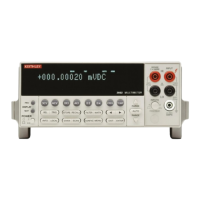Front Panel Operation
2-37
SENSOR
This parameter is used to select the temperature sensor.
4-WIRE-RTD or RTD:
If using a 4-wire or 3-wire RTD
sensor, select 4-WIRE-RTD. If using a 2-wire RTD, select
RTD. Selecting an RTD sensor displays the options for RTD
standards. Five are configured for common RTDs and the
sixth allows you to enter your own RTD factors:
• PT100, D100, F100, PT385 and PT3916 — Selects the
following default parameters for the RTD standards:
• USER — This selection allows you to change one or
more of the RTD factors listed in the above table. The
equation using the factors are shown in Figure 2-11.
SPRTD:
Choosing type SPRTD takes you to the SPRTD
COEFFICIENTS menu, which allows you to program the
following parameters:
R-ZERO: RTD 0˚C resistance value
A4: set A4 coefficient
B4: set B4 coefficient
A7: set A7 coefficient
B7: set B7 coefficient
C7: set C7 coefficient
The ITS-90 standard provides two reference equations for
Standard Platinum Resistance Thermometers covering the
temperature range 18.8033K to 1234.93K. A single SPRTD,
however, usually cannot be used to cover the entire range.
The temperature range is therefore broken up into several
subranges. These subranges depend on the calibration points
of the temperature scale and are based on the melting or tri-
ple points of various pure substances. For an exact list of the
elements needed and details on RTD calibration, refer to
NIST Technical Note 1265 "Guidelines For Realizing the
International Temperature Scale of 1990". In each subrange,
the calibration constants required for that range are listed.
An SPRTD as supplied from the manufacturer will come
with a certificate of calibration that lists the calibration
constants and the temperature range supported. In all cases
except subranges #4 and #7, translation of the supplied
coefficients to Model 2002 values will be required. In most
cases, this translation is done simply entering the A value
(for example) supplied with the SPRTD into the A4 position
(temperatures less than 0˚C) or A7 value (temperatures
above 0˚C) required by the Model 2002. The same procedure
is used for translating the B and, where applicable, C
constants.
The following table should be helpful in translating SPRTD
coefficients to Model 2002 SPRTD coefficients. The Model
2002 supports SPRTD temperatures between 83.805K and
933.473K. For any of the subranges below, only
temperatures within the range from 83.805K to 933.47K will
be measured.
Type Standard Alpha Beta Delta
RZero
(
Ω
at 0°C)
PT100
D100
F100
ITS-90
ITS-90
ITS-90
0.003850
0.003920
0.003900
0.10863
0.10630
0.11000
1.49990
1.49710
1.49589
100.00000
100.00000
100.00000
PT385
PT3916
IPTS-68
IPTS-68
0.003850
0.003916
0.11100
0.11600
1.50700
1.50594
100.00000
100.00000
Coefficients RTD coefficients to Model 2002 coefficients
Subrange #1: 13.8033K - 273.16K Not applicable
Subrange #2: 24.5561K - 273.16K A2 to A4, B2 to B4
Subrange #3: 54.3584K - 273.16K A3 to A4, B3 to B4
Subrange #4: 83.8058K - 273.16K No substitution needed
Subrange #5: 234.3156K - 302.9146K A5 to A4, A5 to A7, B5 to B4
B5 to B7, Set C7 = 0. A5 value entered for both
A4 and A7; B5 value entered for both B4 and B7
Subrange #6: 273.15K - 1234.93K Not applicable
Subrange #7: 273.15K - 933.473K No substitution needed
Subrange #8: 273.15K - 692.677K A8 to A7, B8 to B7, Set C7 = 0
Subrange #9: 273.15K - 505.078K A9 to A7, B9 to B7, Set C7 = 0
Subrange #10: 273.15K - 429.7485K A10 to A7, B10 to B7, Set C7 = 0
Subrange #11: 273.15K - 302.9146K A11 to A7, Set B7 = 0, C7 = 0

